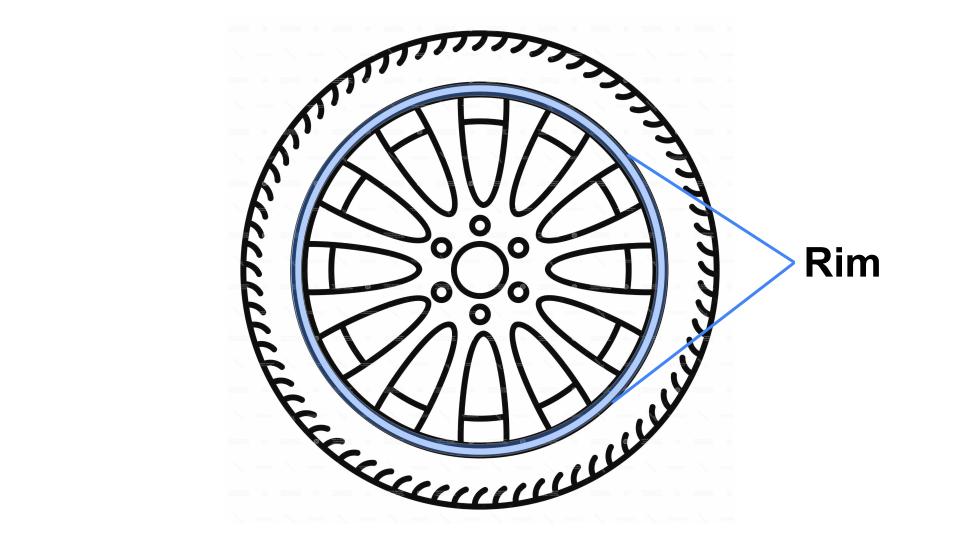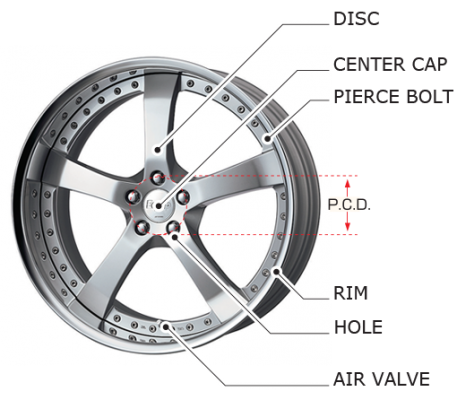Wheels are the entire metal structure that tires attach to, while rims are the outer edge where the tire bead sits. Understanding the wheel versus rim is crucial for vehicle owners and enthusiasts.
Wheels are an essential component of any vehicle, allowing for smooth motion and supporting the vehicle’s weight. The term “wheel” is often misconstrued to mean the same as “rim,” but there’s a clear distinction – the rim is a part of the wheel.
Together, the wheel and tire combination enable effective vehicle performance and road traction.
Knowing the differences between these parts not only aids in maintaining your vehicle but also enhances your knowledge when making modifications or replacements.
Selecting the right wheels and rims is key to ensuring safety, optimizing vehicle performance, and achieving the desired aesthetic for your car or bike.

Credit: www.tireagent.com
Wheels Vs. Rims: Clearing The Confusion
Talk of wheels and rims often brings a cloud of puzzlement. These terms seem the same. But are they? Let us unmix the mix-up, ensure each part gets its correct title, and help you sound like a pro when discussing car parts.
Terminology In The Automotive World
The words ‘wheel’ and ‘rim’ toss up much confusion. A wheel is the entire metal part that tires attach to. A rim is only a portion of the wheel. It forms the outer edge where the tire grips on.
Think of the wheel as a pizza and the rim as the crust. They are part of the same thing, but distinct pieces.
Key Differences to Remember:
- Wheel: Complete unit, including the rim and hub
- Rim: Outer part, that holds the tire in place
Common Misconceptions
| Misconception | Reality |
|---|---|
| The rim and wheel are the same. | The rim is only a part of the wheel. |
| You buy rims for style only. | Rims can influence performance too. |
| Size doesn’t matter for rims. | The right rim size is crucial. |
People often speak of buying new rims when they mean wheels. Rims add flair, yes, but they also affect how cars handle them.
Size is key. The wrong rim can mean a bad fit for your tires, leading to a rough ride or worse.
Anatomy Of A Wheel
The term “wheel” often brings to mind the entire assembly that rolls a vehicle along, but in reality, a wheel consists of distinct parts, each contributing a vital function.
To truly understand what keeps your car cruising, let’s dive into the anatomy of a wheel.
Core Components
A wheel includes several key components:
- Rim – The outer part of the wheel.
- Hub – Centers the wheel on the vehicle.
- Spokes – Connect the hub to the rim.
- Wheel disc – Provides structural support.
Function Of Each Part
Each part of a wheel has a special role:
| Part | Function |
|---|---|
| Rim | Holds the tire and maintains its shape. |
| Hub | Ensures the wheel attaches securely to the vehicle. |
| Spokes | Distribute vehicle weight and absorb shocks from the road. |
| Wheel disc | Supports the wheel structure and withstands stress. |
Rims Explained
Rims serve as the outer edge of a wheel. They support the tire and connect to the wheel’s hub through spokes. In discussing the differences between wheels and rims, understanding rims is crucial.
This section dives into the nuances of rims, revealing their roles and the diverse materials and designs available.
Rim Roles In Wheel Structure
Rims carry out vital functions. They secure the tire to the wheel and bear the vehicle’s load. A solid rim ensures optimal tire pressure and maintains vehicle balance. Rims contribute to a smooth ride.
- Support for Tires: Rims hold the tires in place and provide a seal that keeps air inside.
- Vehicle Load Bearing: Rims support the car’s weight and transfer it to the tires.
- Balancing: Well-designed rims help maintain the balance of the car while moving.
- Aesthetics: Rims also enhance a vehicle’s looks.
Material And Design Varieties
Materials and design not only impact appearance but also influence performance.
Different materials offer benefits in weight, durability, and strength.
| Material | Benefits | Common Uses |
|---|---|---|
| Steel | Durable, cost-effective | Off-road vehicles, trucks |
| Alloy | Lightweight, strong | Sports cars, performance vehicles |
| Carbon Fiber | Ultra-lightweight, top performance | High-performance and luxury cars |
Designs vary from simple, flat faces to intricate, multi-spoke configurations. Each design impacts the car’s handling and its look.
- Simple Designs: Favor durability and ease of maintenance.
- Multi-Spoke Designs: Reduce weight for better handling but can be harder to clean.

Credit: www.tireagent.com
When Rims Become Wheels
The transition from a rim to a wheel is a key concept in vehicle dynamics. Rims refer to the outer edge of a wheel, holding the tire in place.
Wheels, on the other hand, are complete assemblies that enable smooth vehicle movement.
The Assembly Process
A wheel comes to life through the assembly process. Here’s how it unfolds:
- The rim is secured to the hub.
- Tires are mounted onto the rims.
- Air is filled into the tires to the correct pressure.
- The wheel is now complete and ready for action.
During this process, the rim becomes part of a wheel. A wheel is not just the rim but also includes the tire and hub.
Interchangeable Use In Conversation
Often, you’ll hear people use ‘rims’ and ‘wheels’ interchangeably. This is common in everyday conversations:
- “Nice wheels!” could mean the entire wheel or just the rims.
- A car enthusiast may speak about custom rims when they mean the style of the entire wheel.
Although not technically correct, the terms have become synonymous in casual talk.
Impact On Vehicle Performance
Impact on Vehicle Performance plays a crucial role in driving experiences. Understanding how wheels and rims contribute to this impact is key. Wheels and rims might sound similar, but they have distinct functions.
A wheel is the entire structure that rotates to move the vehicle. The rim is just a part of the wheel where the tire attaches. These components affect not just the car’s look, but also its handling and efficiency.
Influence On Handling
Rims and wheels directly affect how a vehicle handles on the road. The right size and type ensure smooth driving. Too large or heavy rims can make steering harder. Light and strong wheels improve performance.
- Size: Larger rims may offer better grip but can reduce steering response.
- Material: Aluminum rims are lighter and can improve handling over steel.
- Width: Wider wheels can enhance stability during turns.
Rim And Wheel Selection For Optimal Efficiency
Choosing the best rim and wheel combo can save fuel and lower emissions. Lighter wheels need less energy to move. This leads to better gas mileage.
Keep your vehicle’s original specifications in mind during selection for the best efficiency.
| Rim Type | Benefits |
|---|---|
| Alloy | Better heat dissipation helping with brake performance |
| Steel | Durability and lower cost |
| Carbon Fiber | Ultra-lightweight leading to quick acceleration |
Remember, the right balance of rim and wheel weight ensures peak efficiency. Check your manufacturer’s recommendations and consider the terrain to find the best fit for your vehicle.
Maintenance And Care
Maintenance and care of wheels and rims are crucial. It ensures your safety on the road. Proper care keeps wheels and rims running smooth. This also means fewer expenses in the long run.
We’ll dive into routine checks and how to fix common issues.
Routine Checks And Balancing
- Inspect tire pressure monthly. Use a reliable gauge.
- Look for damage or wear on tires and rims regularly.
- Rotate tires every 5,000 to 8,000 miles to prevent uneven wear.
- Balance your wheels. It stops vibration and extends tire life.
- Wheel alignment is key. It prevents uneven tire wear and steering issues.
Common Issues And Solutions
| Issue | Solution |
|---|---|
| Vibrations while driving | Balance wheels and check alignment. |
| Rapid tire wear | Rotate tires and align wheels. |
| Visible rim damage | Replace or repair rims to avoid safety hazards. |
| Air leaks in tire | Seal the rim properly or replace it if necessary. |
| Bent rims | Professional repair or replacement is needed. |

Credit: wheelsasap.com
FAQs on Rims vs Wheels
Are Wheel And Rim The Same Thing?
No, the wheel and rim are not the same thing. The rim is part of the wheel, where the tire is mounted, while the wheel refers to the entire assembly.
Why Do People Call Wheels Rims?
People often use “rims” to refer to wheels due to the rim being a prominent and visible part of a wheel. This common parlance simplifies the technical distinction between the entire wheel assembly and the outer edge where the tire attaches.
Do You Need Rims On Your Wheels?
Yes, rims are necessary as they secure the tire to the wheel and provide support for a smooth ride. They also contribute to vehicle performance and aesthetics.
What Is Technically A Wheel?
A wheel is a circular component that rotates on an axle, enabling easy motion and transport for various vehicles and machinery. It typically consists of a rim and spokes.
Conclusion
Understanding the distinction between wheels and rims is crucial for vehicle maintenance and customization. These components play key roles in your car’s performance and aesthetics.
To choose the right set-up, consider their specific functions and compatibility with your vehicle. Embrace this knowledge to make informed decisions and enhance your driving experience.
Keep rolling with confidence and style!
